您好,登錄后才能下訂單哦!
您好,登錄后才能下訂單哦!
這篇文章給大家分享的是有關mysql存儲過程是什么的內容。小編覺得挺實用的,因此分享給大家做個參考,一起跟隨小編過來看看吧。
存儲過程(Stored Procedure)是在大型數據庫系統中,一組為了完成特定功能的SQL 語句集,存儲在數據庫中,經過第一次編譯后調用不需要再次編譯,用戶通過指定存儲過程的名字并給出參數(如果該存儲過程帶有參數)來執行它。存儲過程是數據庫中的一個重要對象。
1、能完成較復雜的判斷和運算
2、可編程行強,靈活
3、SQL編程的代碼可重復使用
4、執行的速度相對快一些
5、減少網絡之間的數據傳輸,節省開銷
1、創建存儲過程的簡單語法
create procedure 名稱() begin ......... end
2、創建一個簡單的存儲過程
create procedure testa() begin select * from users; select * from orders; end;
3、調用存儲過程
call testa();
運行結果如圖(1)和圖(2):
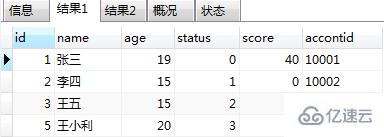
圖(1)

圖(2)
1、先通過一個簡單的例子來學習變量的聲明和賦值
create procedure test2() begin -- 使用 declare語句聲明一個變量 declare username varchar(32) default ''; -- 使用set語句給變量賦值 set username='xiaoxiao'; -- 將users表中id=1的名稱賦值給username select name into username from users where id=1; -- 返回變量 select username; end;
2、概括
(1)、變量的聲明使用declare,一句declare只聲明一個變量,變量必須先聲明后使用;
(2)、變量具有數據類型和長度,與mysql的SQL數據類型保持一致,因此甚至還能制定默認值、字符集和排序規則等;
(3)、變量可以通過set來賦值,也可以通過select into的方式賦值;
(4)、變量需要返回,可以使用select語句,如:select 變量名。
1、變量作用域說明:
(1)、存儲過程中變量是有作用域的,作用范圍在begin和end塊之間,end結束變量的作用范圍即結束。
(2)、需要多個塊之間傳值,可以使用全局變量,即放在所有代碼塊之前
(3)、傳參變量是全局的,可以在多個塊之間起作用
2、通過一個實例來驗證變量的作用域
需求: 創建一個存儲過程,用來統計表users、orders表中行數數量和orders表中的最大金額和最小金額
create procedure test3() begin begin declare userscount int default 0; -- 用戶表中的數量 declare ordercount int default 0; -- 訂單表中的數量 select count(*) into userscount from users; select count(*) into ordercount from orders; select userscount,ordercount; -- 返回用戶表中的數量、訂單表中的數量 end; begin declare maxmoney int default 0; -- 最大金額 declare minmoney int default 0; -- 最小金額 select max(money) into maxmoney from orders; select min(money) into minmoney from orders; select maxmoney,minmoney; -- 返回最金額、最小金額 end; end;
調用以上存儲過程,結果如圖(3)和圖(4):

(3)

(4)
3、我將過程test(3)改為如下:
create procedure test3()
begin
begin
declare userscount int default 0; -- 用戶表中的數量
declare ordercount int default 0; -- 訂單表中的數量
select count(*) into userscount from users;
select count(*) into ordercount from orders;
select userscount,ordercount; -- 返回用戶表中的數量、訂單表中的數量
end;
begin
declare maxmoney int default 0; -- 最大金額
declare minmoney int default 0; -- 最小金額
select max(money) into maxmoney from orders;
select min(money) into minmoney from orders;
select userscount,ordercount,maxmoney,minmoney; -- 返回最金額、最小金額
end;
end;
再次調用call test3(); 會報錯如圖(5):

圖(5)
4、將userscount,ordercount改為全局變量,再次驗證
create procedure test3()
begin
declare userscount int default 0; -- 用戶表中的數量
declare ordercount int default 0; -- 訂單表中的數量
begin
select count(*) into userscount from users;
select count(*) into ordercount from orders;
select userscount,ordercount; -- 返回用戶表中的數量、訂單表中的數量
end;
begin
declare maxmoney int default 0; -- 最大金額
declare minmoney int default 0; -- 最小金額
select max(money) into maxmoney from orders;
select min(money) into minmoney from orders;
select userscount,ordercount,maxmoney,minmoney; -- 返回最金額、最小金額
end;
end;
再次調用call test3(); 會報錯如圖(6)和圖(7):

圖(6)

圖(7)
因此,存儲過程中變量的作用域,作用范圍在begin和end塊之間,end結束變量的作用范圍即結束
1、基本語法
create procedure 名稱([IN|OUT|INOUT] 參數名 參數數據類型 ) begin ......... end
存儲過程的參數類型有:IN,OUT,INOUT,下面分別介紹這個三種類型:
2、存儲過程的傳出參數IN
說明:
(1)、傳入參數:類型為in,表示該參數的值必須在調用存儲過程事指定,如果不顯示指定為in,那么默認就是in類型。
(2)、IN類型參數一般只用于傳入,在調用過程中一般不作為修改和返回
(3)、如果調用存儲過程中需要修改和返回值,可以使用OUT類型參數
通過一個實例來演示:
需求:編寫存儲過程,傳入id,根據id返回name
create procedure test4(userId int) begin declare username varchar(32) default ''; declare ordercount int default 0; select name into username from users where id=userId; select username; end;
運行如圖(8)
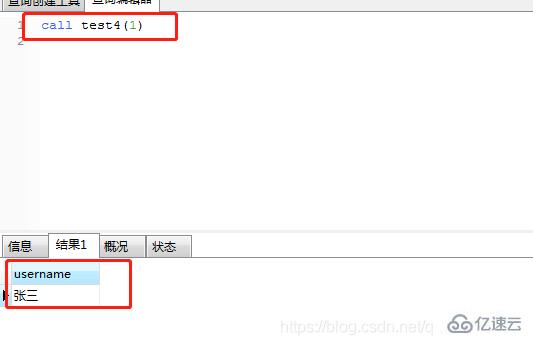
圖(8)
3、存儲過程的傳出參數out
需求:調用存儲過程時,傳入userId返回該用戶的name
create procedure test5(in userId int,out username varchar(32))
begin
select name into username from users where id=userId;
end;
調用及運行結果如圖(9):

圖(9)
概括:
1、傳出參數:在調用存儲過程中,可以改變其值,并可返回;
2、out是傳出參數,不能用于傳入參數值;
3、調用存儲過程時,out參數也需要指定,但必須是變量,不能是常量;
4、如果既需要傳入,同時又需要傳出,則可以使用INOUT類型參數
(3).存儲過程的可變參數INOUT
需求:調用存儲過程時,傳入userId和userName,即使傳入,也是傳出參數。
create procedure test6(inout userId int,inout username varchar(32)) begin set userId=2; set username=''; select id,name into userId,username from users where id=userId; end;
調用及運行結果如圖(10)
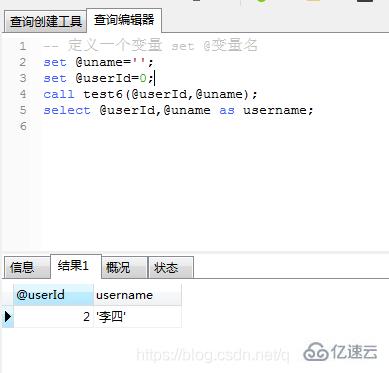
圖(10)
概括:
1、可變變量INOUT:調用時可傳入值,在調用過程中,可修改其值,同時也可返回值;
2、INOUT參數集合了IN和OUT類型的參數功能;
3、INOUT調用時傳入的是變量,而不是常量;
1、基本結構
(1)、條件語句基本結構:
if() then...else...end if;
(2)、多條件判斷語句:
if() then... elseif() then... else ... end if;
2、實例
實例1:編寫存儲過程,如果用戶userId是偶數則返回username,否則返回userId
create procedure test7(in userId int) begin declare username varchar(32) default ''; if(userId%2=0) then select name into username from users where id=userId; select username; else select userId; end if; end;
調用及運行結果如圖(11)和圖(12):
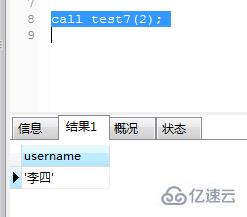
圖(11)
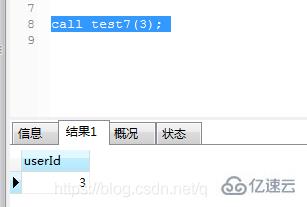
圖(12)
2、存儲過程的多條件語句應用示例
需求:根據用戶傳入的uid參數判斷
(1)、如果用戶狀態status為1,則給用戶score加10分;
(2)、 如果用戶狀態status為2,則給用戶score加20分;
(3)、 其他情況加30分
create procedure test8(in userid int) begin declare my_status int default 0; select status into my_status from users where id=userid; if(my_status=1) then update users set score=score+10 where id=userid; elseif(my_status=2) then update users set score=score+20 where id=userid; else update users set score=score+30 where id=userid; end if; end;
調用程之前的users表的數據如圖(13),調用 call test8(1); 及運行結果圖(14):

圖(13)

圖(14)
1、while語句
(1)、while語句的基本結構
while(表達式) do ...... end while;
(2)、示例
需求:使用循環語句,向表test1(id)中插入10條連續的記錄
create procedure test9() begin declare i int default 0; while(i<10) do begin select i; set i=i+1; insert into test1(id) values(i); end; end while; end;
調用及運行結果結果如圖(15)和圖(16):
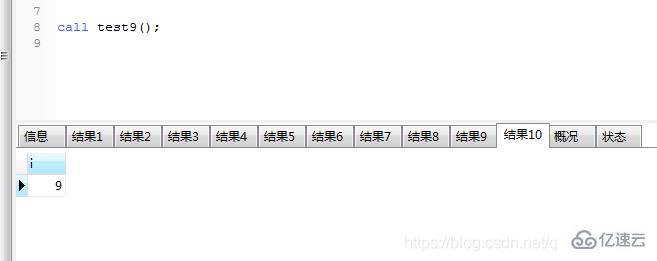
圖(15)
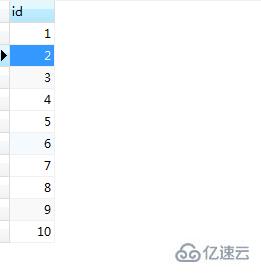
圖(16)
2、repeat語句
(1)、repeat語句基本的結構:
repeat...until...end repeat;
(2)、示例
需求:給test1表中的id字段插入數據,從1到10
create procedure test10() begin declare i int default 0; repeat begin select i; set i=i+1; insert into test1(id) values(i); end; until i>=10 -- 如果i>=10,則跳出循環 end repeat; end;
調用及運行結果結果如圖(17)和圖(18)
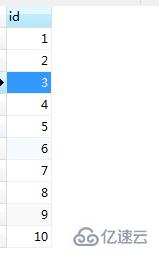
圖(17)

圖(18)
概括:
until判斷返回邏輯真或者假,表達式可以是任意返回真或者假的表達式,只有當until語句為真是,循環結束。
1、什么是游標
游標是保存查詢結果的臨時區域
2、示例
需求:編寫存儲過程,使用游標,把users表中 id為偶數的記錄逐一更新用戶名
create procedure test11() begin declare stopflag int default 0; declare username VARCHAR(32); -- 創建一個游標變量,declare 變量名 cursor ... declare username_cur cursor for select name from users where id%2=0; -- 游標是保存查詢結果的臨時區域 -- 游標變量username_cur保存了查詢的臨時結果,實際上就是結果集 -- 當游標變量中保存的結果都查詢一遍(遍歷),到達結尾,將變量stopflag設置為1,用于循環中判斷是否結束 declare continue handler for not found set stopflag=1; open username_cur; -- 打卡游標 fetch username_cur into username; -- 游標向前走一步,取出一條記錄放到變量username中 while(stopflag=0) do -- 如果游標還沒有結尾,就繼續 begin -- 在用戶名前門拼接 '_cur' 字符串 update users set name=CONCAT(username,'_cur') where name=username; fetch username_cur into username; end; end while; -- 結束循環 close username_cur; -- 關閉游標 end;
調用結果如圖(19):

圖(19)
函數與存儲過程最大的區別是函數必須有返回值,否則會報錯
1、一個簡單的函數
create function getusername(userid int) returns varchar(32) reads sql data -- 從數據庫中讀取數據,但不修改數據 begin declare username varchar(32) default ''; select name into username from users where id=userid; return username; end;
調用及運行結果如圖(20):
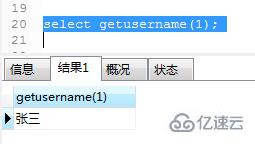
圖(20)
概括:
1.創建函數使用create function 函數名(參數) returns 返回類型;
2.函數體放在begin和end之間;
3.returns指定函數的返回值;
4.函數調用使用select getusername()。
2、示例
需求:根據userid,獲取accoutid,id,name組合成UUID作為用戶的唯一標識
create function getuuid(userid int) returns varchar(64) reads sql data -- 從數據庫中讀取數據,但不修改數據 begin declare uuid varchar(64) default ''; select concat(accontid,'_',id,'_',name) into uuid from users where id=userid; return uuid; end;
調用及運行結果如圖(21)
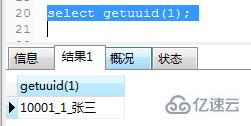
圖(21)
觸發器與函數、存儲過程一樣,觸發器是一種對象,它能根據對表的操作時間,觸發一些動作,這些動作可以是insert,update,delete等修改操作。
(1)、需求:出于審計目的,當有人往表users插入一條記錄時,把插入的userid,username,插入動作和操作時間記錄下來。
create trigger tr_users_insert after insert on users for each row begin insert into oplog(userid,username,action,optime) values(NEW.id,NEW.name,'insert',now()); end;
創建成功后,給uses表中插入一條記錄:
insert into users(id,name,age,status,score,accontid) values(6,'小周',23,1,'60','10001');
執行成功后,打開oplog表,可以看到oplog表中插入了一條記錄如圖(22)

圖(22)
(2)、總結
1、創建觸發器使用create trigger 觸發器名
2、什么時候觸發?after insert on users,除了after還有before,是在對表操作之前(before)或者之后(after)觸發動作的。
3、對什么操作事件觸發? after insert on users,操作事件包括insert,update,delete等修改操作;
4、對什么表觸發? after insert on users
5、影響的范圍?for each row
需求:出于審計目的,當刪除users表時,記錄刪除前該記錄的主要字段值
create trigger tr_users_delete before delete on users for each row begin insert into oplog(userid,username,action,optime) values(OLD.id,OLD.name,'delete',now()); end;
刪除users表中的一條記錄
delete from users where id=6;
執行成功后,打開oplog表,可以看到oplog表中插入了一條記錄如圖(23)

圖(23)
1、case分支
(1)、基本語法結構
case ... when ... then.... when.... then.... else ... end case;
(2)、示例
users表中,根據userid獲取status值,如果status為1,則修改score為10;如果status為2,則修改為20,如果status3,則修改為30;否則修改為40。
create procedure testcate(userid int) begin declare my_status int default 0; select status into my_status from users where id=userid; case my_status when 1 then update users set score=10 where id=userid; when 2 then update users set score=20 where id=userid; when 3 then update users set score=30 where id=userid; else update users set score=40 where id=userid; end case; end;
調用過程 call testcate(1); ,執行結果如圖(24);
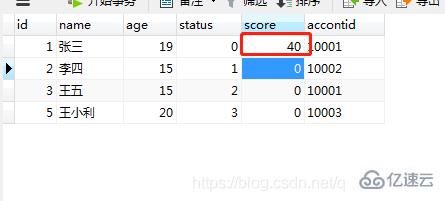
圖(24)
1、使用存儲過程+事件事件一個簡單的實現福彩3D開獎
需求:設計一個福彩的開獎過程,沒3分鐘開獎一次
第一步:先編寫一個存儲過程open_lottery,產生3個隨機數,生成一條開獎記錄
第二步:編寫一個時間調度器,每3分鐘調用一次這個過程
create procedure open_lottery() begin insert into lottery(num1,num2,num3,ctime) select FLOOR(rand()*9)+1,FLOOR(rand()*9)+1,FLOOR(rand()*9)+1,now(); end;
create event if not exists lottery_event -- 創建一個事件 on schedule every 3 minute -- on schedule 什么時候來執行,沒三分鐘執行一次 on completion preserve do call open_lottery;
運行結果如圖(25)
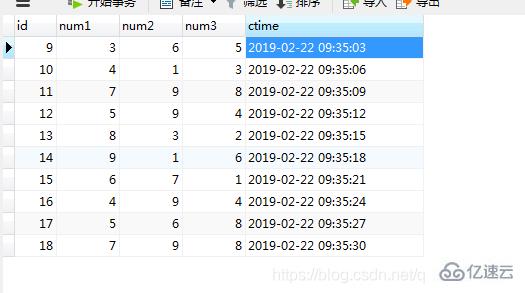
圖(25)
注意,如果event之一沒有運行,請按照以下辦法解決:
(1)、 show variables like '%event_scheduler%';
set global event_scheduler=on;
(2)、 alert event lottery_event enable;
2、解析event的創建格式
(1)、基本語法
create event[IF NOT EXISTS]event_name -- 創建使用create event ON SCHEDULE schedule -- on schedule 什么時候來執行 [ON COMPLETION [NOT] PRESERVE] -- 調度計劃執行完成后是否還保留 [ENABLE | DISABLE] -- 是否開啟事件,默認開啟 [COMMENT 'comment'] -- 事件的注釋 DO sql_statement; -- 這個調度計劃要做什么?
(2)、執行時間說明
1.單次計劃任務示例
在2019年2月1日4點執行一次
on schedule at '2019-02-01 04:00:00'
2. 重復計劃執行
on schedule every 1 second 每秒執行一次
on schedule every 1 minute 每分鐘執行一次
on schedule every 1 day 沒天執行一次
3.指定時間范圍的重復計劃任務
每天在20:00:00執行一次
on schedule every 1 day starts '2019-02-01 20:00:00'
1、lottery表

2、oplog表

3、orders表

4、test1表

5、user表

感謝各位的閱讀!關于“mysql存儲過程是什么”這篇文章就分享到這里了,希望以上內容可以對大家有一定的幫助,讓大家可以學到更多知識,如果覺得文章不錯,可以把它分享出去讓更多的人看到吧!
免責聲明:本站發布的內容(圖片、視頻和文字)以原創、轉載和分享為主,文章觀點不代表本網站立場,如果涉及侵權請聯系站長郵箱:is@yisu.com進行舉報,并提供相關證據,一經查實,將立刻刪除涉嫌侵權內容。